东北地区振兴规划 英文版(Plan of Revitalizing Northeast China) 解读规划
兴辽英才计划英语
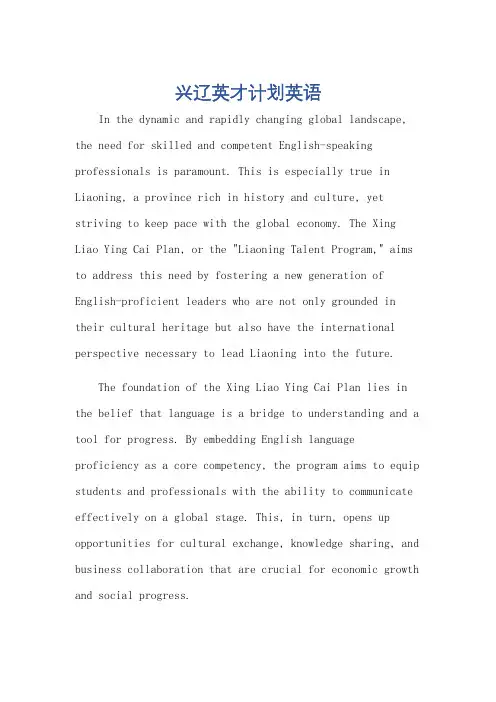
兴辽英才计划英语In the dynamic and rapidly changing global landscape, the need for skilled and competent English-speaking professionals is paramount. This is especially true in Liaoning, a province rich in history and culture, yet striving to keep pace with the global economy. The Xing Liao Ying Cai Plan, or the "Liaoning Talent Program," aims to address this need by fostering a new generation of English-proficient leaders who are not only grounded in their cultural heritage but also have the international perspective necessary to lead Liaoning into the future.The foundation of the Xing Liao Ying Cai Plan lies in the belief that language is a bridge to understanding and a tool for progress. By embedding English languageproficiency as a core competency, the program aims to equip students and professionals with the ability to communicate effectively on a global stage. This, in turn, opens up opportunities for cultural exchange, knowledge sharing, and business collaboration that are crucial for economic growth and social progress.The implementation of the plan is comprehensive and multifaceted. It involves enhancing English education atall levels, from primary schools to universities, and beyond. This includes the integration of innovative teaching methods and technologies that make learning more engaging and effective. It also involves professional development programs for working adults, providing them with the opportunity to upskill and remain relevant in today's globalized workplace.The benefits of the Xing Liao Ying Cai Plan are wide-reaching. For students, it opens up a world ofopportunities for further education and career advancement. For professionals, it equips them with the skills necessary to compete on a global stage. For Liaoning, it paves the way for increased international cooperation and investment, driving economic growth and social progress.The success of the Xing Liao Ying Cai Plan hinges on the active participation and collaboration of all stakeholders. Governments, educational institutions, businesses, and communities must work together to create an environment that fosters language learning and culturalunderstanding. By doing so, Liaoning can ensure that its future leaders are not only skilled and competent but also have the vision and ambition to take the province to new heights.The Xing Liao Ying Cai Plan represents a bold step towards building a more inclusive and connected Liaoning. By prioritizing English proficiency, the program is paving the way for a new generation of leaders who are ready to embrace the challenges and opportunities of the globalized world. As these leaders grow and prosper, so too will Liaoning, emerging as a vibrant and dynamic center of learning, innovation, and economic growth.**兴辽英才计划英语:培育国际化人才,助力辽宁振兴** 在全球化的浪潮中,英语作为国际交流的通用语言,其重要性日益凸显。
四级乡村振兴的英语作文素材
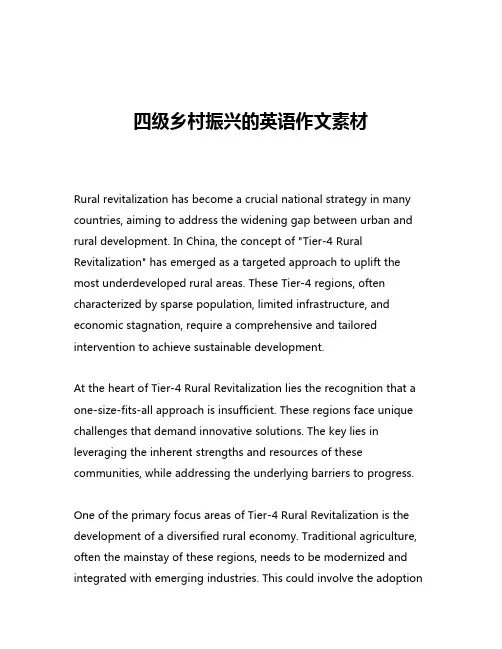
四级乡村振兴的英语作文素材Rural revitalization has become a crucial national strategy in many countries, aiming to address the widening gap between urban and rural development. In China, the concept of "Tier-4 Rural Revitalization" has emerged as a targeted approach to uplift the most underdeveloped rural areas. These Tier-4 regions, often characterized by sparse population, limited infrastructure, and economic stagnation, require a comprehensive and tailored intervention to achieve sustainable development.At the heart of Tier-4 Rural Revitalization lies the recognition that a one-size-fits-all approach is insufficient. These regions face unique challenges that demand innovative solutions. The key lies in leveraging the inherent strengths and resources of these communities, while addressing the underlying barriers to progress.One of the primary focus areas of Tier-4 Rural Revitalization is the development of a diversified rural economy. Traditional agriculture, often the mainstay of these regions, needs to be modernized and integrated with emerging industries. This could involve the adoptionof smart farming technologies, the cultivation of high-value crops, and the promotion of agri-tourism. By diversifying the economic base, Tier-4 communities can reduce their reliance on a single sector and create new avenues for employment and income generation.Alongside economic diversification, the improvement of rural infrastructure is crucial. Tier-4 regions often lack access to reliable transportation networks, efficient communication systems, and essential public services. Investing in the construction of roads, bridges, and transportation hubs can significantly enhance the connectivity of these areas, facilitating the movement of goods, services, and people. Additionally, the deployment of modern telecommunications infrastructure, such as high-speed internet and digital services, can bridge the digital divide and enable Tier-4 communities to participate in the digital economy.Education and human capital development are also key pillars of Tier-4 Rural Revitalization. These regions often face challenges in attracting and retaining skilled professionals, hindering the development of a robust local workforce. Strategies such as providing incentives for skilled individuals to work in Tier-4 areas, establishing vocational training programs, and strengthening the quality of rural education can help build a skilled and adaptable workforce capable of driving local development.Environmental sustainability is another crucial aspect of Tier-4 Rural Revitalization. These regions, often rich in natural resources, need to strike a balance between economic growth and ecological preservation. Initiatives such as promoting sustainable agriculture practices, developing renewable energy sources, and implementing effective waste management systems can help Tier-4 communities become more environmentally responsible and resilient.The success of Tier-4 Rural Revitalization also depends on the active engagement and empowerment of local communities. By fostering a sense of ownership and participation, rural residents can become active agents of change, contributing their unique knowledge, skills, and cultural heritage to the development process. This can involve the establishment of community-based organizations, the facilitation of local decision-making, and the integration of traditional practices with modern approaches.Ultimately, Tier-4 Rural Revitalization is a complex and multifaceted endeavor that requires a coordinated effort from various stakeholders, including government agencies, private enterprises, civil society organizations, and local communities. By addressing the unique challenges faced by these regions and leveraging their inherent strengths, Tier-4 Rural Revitalization can pave the way for inclusive and sustainable development, ultimately bridging the urban-rural divide and ensuring the prosperity of all.。
十四五计划英文版
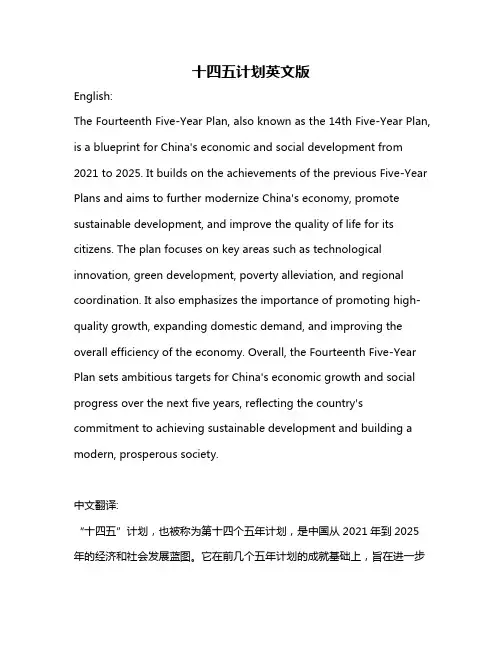
十四五计划英文版English:The Fourteenth Five-Year Plan, also known as the 14th Five-Year Plan, is a blueprint for China's economic and social development from 2021 to 2025. It builds on the achievements of the previous Five-Year Plans and aims to further modernize China's economy, promote sustainable development, and improve the quality of life for its citizens. The plan focuses on key areas such as technological innovation, green development, poverty alleviation, and regional coordination. It also emphasizes the importance of promoting high-quality growth, expanding domestic demand, and improving the overall efficiency of the economy. Overall, the Fourteenth Five-Year Plan sets ambitious targets for China's economic growth and social progress over the next five years, reflecting the country's commitment to achieving sustainable development and building a modern, prosperous society.中文翻译:“十四五”计划,也被称为第十四个五年计划,是中国从2021年到2025年的经济和社会发展蓝图。
介绍乡村振兴战略英语作文
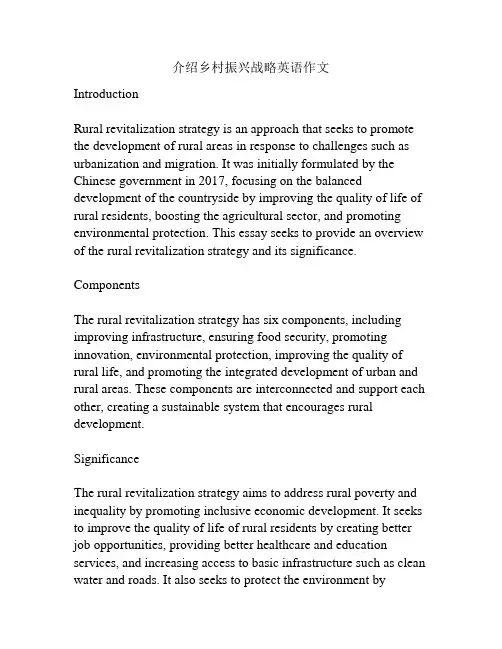
介绍乡村振兴战略英语作文IntroductionRural revitalization strategy is an approach that seeks to promote the development of rural areas in response to challenges such as urbanization and migration. It was initially formulated by the Chinese government in 2017, focusing on the balanced development of the countryside by improving the quality of life of rural residents, boosting the agricultural sector, and promoting environmental protection. This essay seeks to provide an overview of the rural revitalization strategy and its significance.ComponentsThe rural revitalization strategy has six components, including improving infrastructure, ensuring food security, promoting innovation, environmental protection, improving the quality of rural life, and promoting the integrated development of urban and rural areas. These components are interconnected and support each other, creating a sustainable system that encourages rural development.SignificanceThe rural revitalization strategy aims to address rural poverty and inequality by promoting inclusive economic development. It seeks to improve the quality of life of rural residents by creating better job opportunities, providing better healthcare and education services, and increasing access to basic infrastructure such as clean water and roads. It also seeks to protect the environment bypromoting sustainable agricultural practices and protecting natural resources.ChallengesDespite the benefits of rural revitalization, there are also challenges that must be addressed in the implementation of the strategy. These include inadequate funding, lack of public-private partnerships, and insufficient engagement with rural communities. Addressing these challenges requires a collaborative effort between the government, private sector, and local communities to ensure the effective implementation of the strategy.ConclusionIn conclusion, the rural revitalization strategy is an important policy tool that seeks to promote sustainable development in rural areas. It provides a comprehensive framework for improving the quality of life of rural residents and promoting the integration of urban and rural development. By addressing the challenges facing rural areas, rural revitalization can lead to social, economic, and environmental progress, creating a more sustainable and inclusive future.ImplementationIn order to successfully implement the rural revitalization strategy, it is important to prioritize the needs and aspirations of rural communities and promote widespread participation in decision-making processes. Effective implementation also requires a clear and coordinated institutional framework that encourages collaboration at the local and national levels. Additionally, a strongemphasis must be placed on promoting innovation and entrepreneurship to stimulate rural economic growth and diversification.In regard to infrastructure development, the strategy emphasizes the need to improve transportation, communication, and energy networks in rural areas. This includes the expansion of broadband technology to improve access to information and enhance economic opportunities. Additionally, improving the healthcare system and education services can help attract and retain human talent necessary for long-term rural development.Ensuring food security is also a critical component of the rural revitalization strategy. This can be achieved through promoting sustainable agricultural practices and investment in modern agricultural technologies. Furthermore, diversifying agricultural production can help improve rural incomes and reduce dependency on a single crop or commodity.Environmental protection is also a key element of the strategy, emphasizing the importance of sustainable land use practices and the protection of natural resources. This includes promoting clean energy sources such as wind and solar power and reducing pollution and waste in rural communities.Benefits of Rural RevitalizationBy prioritizing the needs of rural communities and promoting inclusive economic growth, rural revitalization can result in several key benefits. For local communities, it can improve access to basicservices, boost income levels, and enhance the overall quality of life. By attracting investments and encouraging entrepreneurship, it can create new job opportunities and stimulate economic growth.From a national perspective, revitalizing rural areas can help reduce economic disparities between rural and urban regions, promote balanced regional development, and strengthen national food security. Additionally, sustainable land use practices and environmental protection can help create a more resilient natural resource base, reducing the impacts of climate change and promoting long-term environmental sustainability.ConclusionIn conclusion, the rural revitalization strategy is a holistic approach to promoting sustainable rural development. By prioritizing the needs and aspirations of rural communities, improving infrastructure, ensuring food security, promoting innovation, environmental protection and the integration of urban and rural development, it can create a more balanced and sustainable future for rural areas. While challenges such as inadequate funding and insufficient engagement with rural communities exist, addressing these issues can help unlock the full potential of rural revitalization as a tool for inclusive economic growth and sustainable development.本文讲述了乡村振兴战略的实施和好处。
家乡振兴英语作文通用
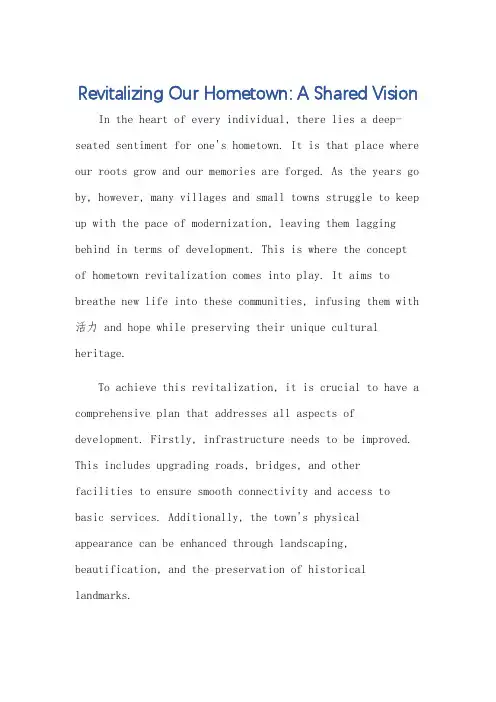
Revitalizing Our Hometown: A Shared Vision In the heart of every individual, there lies a deep-seated sentiment for one's hometown. It is that place where our roots grow and our memories are forged. As the years go by, however, many villages and small towns struggle to keep up with the pace of modernization, leaving them lagging behind in terms of development. This is where the concept of hometown revitalization comes into play. It aims to breathe new life into these communities, infusing them with 活力 and hope while preserving their unique cultural heritage.To achieve this revitalization, it is crucial to have a comprehensive plan that addresses all aspects of development. Firstly, infrastructure needs to be improved. This includes upgrading roads, bridges, and otherfacilities to ensure smooth connectivity and access to basic services. Additionally, the town's physical appearance can be enhanced through landscaping, beautification, and the preservation of historical landmarks.Moreover, economic development is pivotal. Encouraging small-scale entrepreneurship and promoting local industries can help create job opportunities and boost the local economy. This can be achieved through various measures such as providing financial assistance, skills training, and market access to aspiring entrepreneurs.Cultural preservation is another essential aspect of hometown revitalization. It involves promoting local culture, traditions, and customs to foster a sense of pride and belonging among residents. This can be done through cultural events, festivals, and exhibitions that showcase the town's unique heritage and identity.In addition, education and healthcare are key to sustainable development. Providing quality education to the youth and ensuring access to basic healthcare services are crucial for the overall well-being of the community. This will help create a skilled workforce and reduce health disparities, thereby contributing to the long-term growth and prosperity of the town.However, it is important to note that hometown revitalization is not a one-time event but a continuousprocess. It requires the collective effort and participation of all stakeholders, including government agencies, community organizations, businesses, and individuals. Collaboration and cooperation are essential for implementing effective development strategies and monitoring their progress.In conclusion, hometown revitalization is a vital initiative that aims to transform underdeveloped communities into vibrant and sustainable places. It involves improving infrastructure, promoting economic development, preserving cultural heritage, and enhancing education and healthcare services. By working together and implementing comprehensive plans, we can bring about positive changes in our hometowns and create a better future for ourselves and our loved ones.**家乡振兴:共同的愿景**在每个人的心中,都深藏着对家乡的深厚情感。
东北三省中英文介绍

After the establishment of the People's Republic of China, the Northeast region became an important industrial and grain base for the country, making tremendous contributions to the country's economic construction.
In recent years, the Northeast region has faced challenges in economic restructuring and transformation, while also emerging many new development opportunities and potentials.
Literature
Music and Dance
Film and Television Industry
Art and Culture
04
Economic selopment
Overview of Agricultural Development: The three northeastern provinces have a long history of agricultural development and are important food bases in China. In recent years, with the continuous progress of agricultural technology and the strengthening of policy support, the agricultural output value has steadily increased, providing strong support for regional economic development.
我为振兴发展献良策英语作文初中
我为振兴发展献良策英语作文初中全文共3篇示例,供读者参考篇1My Suggestions for the Revitalization and DevelopmentAs a member of society, I always pay attention to the development of our country. The revitalization and development of a nation require the efforts of every citizen. Today, I would like to offer my suggestions on how we can contribute to the revitalization and development of our country.Firstly, I believe that education plays a crucial role in the development of a nation. Therefore, we should focus on improving the quality of education. We need to invest more resources in education, improve the quality of teachers, and create a more stimulating learning environment for students. By providing our young people with a high-quality education, we can ensure that they have the knowledge and skills needed to contribute to the development of our country.Secondly, I think that innovation is key to the revitalization and development of a nation. We need to encourage innovation and entrepreneurship among our people. We should providesupport and resources to help entrepreneurs turn their ideas into successful businesses. By fostering a culture of innovation, we can drive economic growth and create new opportunities for our country.Thirdly, I believe that environmental protection is essential for the sustainable development of our country. We need to take action to reduce pollution, protect our natural resources, and combat climate change. By implementing sustainable practices and investing in renewable energy sources, we can create a cleaner and healthier environment for future generations.In conclusion, the revitalization and development of our country require the efforts of every citizen. By focusing on education, innovation, and environmental protection, we can create a brighter future for our country. I hope that my suggestions will inspire others to think about how they can contribute to the revitalization and development of our nation.篇2Title: My Suggestions for the Revitalization and DevelopmentAs a student who is passionate about the revitalization and development of our society, I have been thinking about how I can contribute to this cause. Here are some of my suggestions:First and foremost, education plays a crucial role in the development of any nation. Therefore, I believe that we need to improve the quality of education in our schools and colleges. This can be done by investing in better infrastructure, providing training to teachers, and updating the curriculum to make it more relevant to the needs of the modern workforce.Secondly, we need to focus on developing the skills of our youth so that they can contribute effectively to the economy. This can be achieved by providing vocational training programs, internships, and apprenticeships to young people. By equipping them with the necessary skills, we can ensure that they are able to secure good jobs and support themselves and their families.Thirdly, we need to promote entrepreneurship and innovation in order to create more job opportunities and drive economic growth. This can be done by providing funding and support to aspiring entrepreneurs, creating incubators and accelerators for startups, and fostering a culture of creativity and risk-taking.In addition, we need to prioritize environmental sustainability and conservation in our development efforts. This means investing in renewable energy sources, reducing our carbon footprint, and protecting our natural resources. By taking care of our environment, we can ensure a better quality of life for both current and future generations.Lastly, we need to address social issues such as poverty, inequality, and discrimination in order to create a more inclusive and equitable society. This can be achieved by implementing social welfare programs, promoting diversity and inclusivity, and taking a stand against injustice and oppression.In conclusion, the revitalization and development of our society require a collective effort from all of us. By implementing these suggestions and working together towards a common goal, we can build a better future for ourselves and generations to come. Let us all do our part to make a positive impact and contribute to the progress and prosperity of our society. Thank you.篇3I have a proposal for the revitalization and development of our country, which I believe can contribute significantly to theprogress and success of our nation. As a citizen who is deeply committed to the growth and prosperity of our country, I have thought carefully about the challenges we face and the opportunities that lie ahead. In this essay, I would like to present my ideas and suggestions for the future of our nation.First and foremost, I believe that education is the key to the success of any nation. Therefore, I propose that we invest more resources in our education system, ensuring that every child has access to high-quality education regardless of their background or circumstances. By improving our schools, training our teachers, and providing opportunities for lifelong learning, we can ensure that our workforce is well-equipped for the challenges of the modern economy.In addition to education, I believe that we need to focus on innovation and entrepreneurship as drivers of economic growth. We should encourage and support small businesses and startups, providing them with the resources and support they need to succeed. By fostering a culture of innovation and entrepreneurship, we can create new jobs, attract investment, and stimulate economic development in our country.Furthermore, I believe that we need to prioritize sustainability and environmental protection in our developmentplans. Climate change is a global crisis that requires urgent action, and our country can play a leading role in the transition to a greener, more sustainable future. By investing in clean energy, reducing carbon emissions, and protecting our natural resources, we can create a healthier and more prosperous future for our citizens.Finally, I believe that we must prioritize social justice and equality in our policies and programs. In order to truly prosper as a nation, we must ensure that all of our citizens have equal opportunities to succeed, regardless of their race, gender, or background. By addressing systemic inequalities, promoting diversity and inclusion, and empowering marginalized communities, we can build a more just and equitable society for all.In conclusion, I believe that by investing in education, fostering innovation and entrepreneurship, prioritizing sustainability, and promoting social justice, we can revitalize and develop our country for the betterment of all. I urge our leaders and policymakers to consider these ideas and work together to build a brighter future for our nation. Together, we can achieve great things and make our country a shining example for the world. Thank you.。
振兴乡村从我做起作文
振兴乡村从我做起作文(英语带翻译)Revitalization the countryside, start from me With the rapid development of cities, the revitalization of rural areas has become a subject that we cannot ignore. As an ordinary citizen, I feel that I have a responsibility and obligation to participate in this great cause. To revitalize the countryside, starting from me, this is not only a slogan, but also a code of action that I want to put into practice.I think the rural revitalization needs us to pay attention to rural education. Education is the future of the country and the cornerstone of rural development. I am willing to provide more educational resources for rural schools through donations, volunteer teaching and other ways, so as to help rural children receive a better education and lay a solid foundation for their future. At the same time, I will also actively advocate more urban teachers to teach in rural areas to inject new vitality into rural education.I will pay close attention to the development of the rural economy. The development of rural economy is the key to rural revitalization. I will use my professional knowledge and skills to provide advice and suggestions for the development of rural industries, and help them to find industries suitable fortheir own development. At the same time, I will also encourage more entrepreneurs to invest in rural areas to inject new impetus into the development of rural economy.I will also focus on the improvement of the rural environment. Good ecological environment is the premise of rural development. I will actively participate in the rural environment improvement work, advocate a green lifestyle, and promote the implementation of rural garbage classification, sewage treatment and other work. At the same time, I will also pay attention to the protection and inheritance of rural cultural heritage, so that the history and culture of the countryside can be continued and carried forward.I will lead by example, with their own practical actions to influence and drive the people around. I will publicize the importance of rural revitalization to the people around me, and guide them to pay attention to the countryside, support it, and devote themselves to the countryside. I believe that as long as each of us can start from ourselves and contribute to the rural revitalization, our countryside will certainly be able to radiate new vitality and vitality.Revitalizing the countryside starts with me. I will practice this concept with my own actions and make my owncontribution to rural revitalization. I believe that as long as each of us can start from ourselves, our countryside will be able to achieve all-round revitalization and make greater contribution to the prosperity and development of the country.中文翻译:振兴乡村,从我做起随着城市的快速发展,乡村的振兴成为了我们不可忽视的课题。
我为东北振兴发展献良策发言稿
我为东北振兴发展献良策发言稿英文回答:Empowering Northeast China for Revitalized Growth and Prosperity: A Visionary Plan.Introduction:The Northeast Region of China, comprising Heilongjiang, Jilin, and Liaoning provinces, has historically played a pivotal role in the nation's economic and industrial development. However, in recent years, the region has faced challenges, including a decline in heavy industry and a shrinking population. To address these issues and harness the immense potential of the Northeast, we propose a comprehensive plan for its revitalization and sustainable growth.Pillars of the Revitalization Plan:1. Innovation-Driven Industrial Transformation:Leverage the region's existing industrial base as a foundation for advanced manufacturing and high-tech industries.Support research and development in key areas such as aerospace, electronics, and biotechnology.Establish innovation hubs and incubators to foster entrepreneurship and attract skilled professionals.2. Modernized Infrastructure and Connectivity:Upgrade transportation networks, including railways, highways, and airports, to connect the Northeast to domestic and international markets.Develop high-speed internet infrastructure to facilitate digitalization and e-commerce.Enhance logistics capabilities to optimize supplychains and trade efficiency.3. Agricultural Revitalization and Food Security:Utilize the region's vast agricultural lands todevelop a modern and sustainable agricultural sector.Invest in precision farming technologies and value-added processing to increase productivity and profitability.Promote agri-tourism and rural development to create new economic opportunities.4. Cultural Heritage and Tourism Development:Preserve and promote the rich cultural heritage of the Northeast, including its historical sites, museums, and intangible cultural assets.Develop tourism infrastructure and experiences that showcase the region's unique offerings.Utilize cultural tourism as a catalyst for economic diversification and community development.5. Education and Human Capital Development:Invest in high-quality education at all levels, from primary to tertiary.Establish partnerships with universities and research institutions to develop specialized programs in emerging fields.Attract and retain skilled professionals by offering competitive salaries and incentives.6. Environmental Protection and Sustainable Development:Implement comprehensive environmental protection measures to safeguard the region's natural resources.Promote green energy initiatives and reduce carbon emissions.Encourage responsible land use and sustainable practices to protect biodiversity and ecosystem services.Conclusion:By embracing innovation, modernizing infrastructure, revitalizing agriculture, promoting cultural heritage and tourism, and investing in education and sustainable development, we can empower the Northeast Region of China to achieve its full potential. This plan will create new economic opportunities, improve quality of life, and ensure the long-term prosperity of the region and its people.中文回答:振兴东北发展献策。
乡村振兴英文翻译
乡村振兴英文翻译乡村振兴英文翻译乡村振兴英文翻译:rural revitalization国家乡村振兴局:National Administration for Rural Revitalization。
Revitalize的词典释义是to make sth stronger, more active or more healthy :使更强壮;使恢复生机(或健康)例如:revitalize the economy 振兴经济revitalize primary science 重振初等科学例句:全面推进乡村振兴的深度、广度、难度都不亚于脱贫攻坚,决不能有任何喘口气、歇歇脚的想法。
Promoting rural vitalization on all fronts will be no easier than the anti-poverty battle, allowing no letup or sluggish ness.实现全面小康之后,要全面推进乡村振兴,建设更加美丽的乡村。
After the goal of building a moderately prosperous society i n all respects is fulfilled, the government will promote rur al development in all respects and build more beautiful vill ages.The debut of the new administration came after China's announcement of "complete victory" in eradicating absolute poverty, marking the transition of the country's policy priority from poverty alleviation to comprehensively promoting rural vitalization.国家乡村振兴局正式挂牌,既是我国脱贫攻坚战取得全面胜利的一个标志,也是全面实施乡村振兴战略,奔向新生活、新奋斗的起点。
- 1、下载文档前请自行甄别文档内容的完整性,平台不提供额外的编辑、内容补充、找答案等附加服务。
- 2、"仅部分预览"的文档,不可在线预览部分如存在完整性等问题,可反馈申请退款(可完整预览的文档不适用该条件!)。
- 3、如文档侵犯您的权益,请联系客服反馈,我们会尽快为您处理(人工客服工作时间:9:00-18:30)。
By National Development and Reform Commission,Office of the Leading Group for Revitalizing Northeast China andOther Old Industrial Bases of the State Council,People's Republic of ChinaPreambleTo apply the scientific outlook of development, accelerate the pace of revitalizing Northeast China, and promote coordinated regional economic development, the Plan of Revitalizing Northeast China is hereby formulated in line with "The Guidelines of the CPC Central Committee and the State Council on Implementing the Strategy of Revitalizing Northeast China and Other Old Industrial Bases" and " The Outline of the 11th Five-year Plan for National Economic and Social Development (2006-2010)".With emphasis on illustrating national strategies, clarifying government priorities, guiding market behaviors, and identifying general approaches, major objectives and tasks in revitalizing Northeast China, this plan is aimed at coordinating key issues in regional development and enhancing policies and measures to accelerate the process of revitalization.Geographically, areas covered in this plan include the following provinces and cities: Liaoning Province, Jilin Province and Heilongjiang Province as well as Hulunbeier City, Xinggan League, Tongliao City, Chifeng City and Xilinguole League, with the latter five areas seated in the eastern part of Inner Mongolia Autonomous Region. These areas are home to 120 million people and stretch for 1.45 million square kilometers .Development during the 11th Five Year Period (2006-2010) is a major focus in this plan while outlook of key issues may be envisaged as far as the year of 2020.Section I Review of Current SituationSince the strategy for revitalizing Northeast China and other old industrial bases was implemented three years ago, economic and social development in this region has registered accelerated growth, with constantly improving economic strength. Institutional innovation, with the restructuring of state-owned enterprises (referred as "SOEs" hereafter) as a priority, has made much headway. This region is opening up more to the outside world, and significant progresses have been made in technological innovation and structural readjustment. Moreover, mining-induced subsidence areas have been treated comprehensively and shanty areas have experienced successful redevelopment. Pilot projects to transform the economic structure of resource-based cities have been carried out steadily. In addition, infrastructure has been further improved and ecological development and environmental protection efforts have been strengthened. Moreover, urban social security net has taken shape initially and employment has been boosted. The past three years witnessed the most brilliant period of the region since reform and opening up in that the regional economy has expanded substantially and both the urban and rural residents here have received more tangible benefits than ever before. In general, the campaign of "Revitalizing Northeast China" has achieved great progress.The next five to ten years is a crucial period for Northeast China to seek fresh development and all-round rejuvenation, as it is standing at a new starting point. There are many favorable conditions: first, the Central Committee of the Communist Party of China unveiled strategic thoughts like scientific outlook of development and establishment of a socialist harmonious society, both of which enrich concept of reinvigorating Northeast China and highlight future orientation; secondly, sustained, stable and smooth growth of the national economy and the increasingly growing national strength creates an enabling environment to speed up institutional reforms and restructuring in Northeast China; thirdly, constantly improving regional coordination mechanisms facilitate interactions between Northeast China and the Central, Eastern and Western regions, which would be conducive for these regions to achieve shared prosperity and tap on each other's strengths; fourthly, China is more active in participating global competition, utilizing both domestic and foreign resources, and expanding both domestic and overseas markets. Thisprovides further potential opportunities for Northeast China to boost its foreign trade and cooperation, thus opening up wider to the outside world.However, there are some pronounced contradictions and problems in the revitalization process. First, there are institutional obstacles to be removed and vitality to be aroused. The non-public economic sector in this region is still underdeveloped and market still needs to play a bigger role in the economy. Secondly, structural contradictions are still prominent. Proportion of high-tech industry and modern tertiary industry remains small, and the equipment manufacturing industry needs to produce more compatible products and improve its system integration capability. Meanwhile, the intensive and downstream processing capacity in raw materials industry is very low and many enterprises are weak in independent innovation. Thirdly, strong pressures are building up in creating jobs for the unemployed and providing social security. There are some residents still living a difficult life. Fourthly, the region provides declining amount of certain resources and some areas along coast or river are plagued by severe pollution. Fifthly, resource-based cities, and resource-depleted cities in particular, are lack of sustainable development capability, with slow development of alternative industries and huge social and ecological problems. These contradictions and problems mentioned above worth our high attention and call for effective measures.Section II Guiding Ideologies and Objectives of Revitalization2.1 Guiding ideologiesWith Deng Xiaoping Theory and the important thoughts of "Three Representatives" as the major guiding ideologies, we will step up economic and social progress by applying the scientific outlook of development and the theory of building a harmonious socialist society, thus promoting all-round revitalization in Northeast China. The guiding ideologies also involve six aspects: first, to transform development philosophies and enhance economic vitality through deepening reform and open-up; secondly, to improve independent innovation capability and promote restructuring while centering on revitalizing old industrial bases; thirdly, tosolve demanding economic and social problems by accelerating economic transformation in resource-depleted cities; fourthly, to start with raising peoples' living standards and gradually establish a moderately well-off society in an all-around manner; fifthly, to promote balanced development between urban and rural areas and address regional disparity with establishing a new socialist countryside as a priority; sixthly, to enhance capability of sustainable development by boosting a recycling economy.In line with these guiding ideologies, several major measures should be adopted to solve the pronounced contradictions and problems in the revitalization process:First, pace of reform and open-up will be accelerated. We must deepen institutional reforms by establishing modern enterprise system and ownership structure, promoting strategic restructuring of state-owned sector, and cultivating non-public economy. We must increase development vitality by opening up more in both domestic and foreign markets.Secondly, efforts will be enhanced in restructuring and upgrading of industries. We must enhance independent innovation capability by upgrading and optimizing industrial structure. We must also enhance overall competitiveness of industries by spreading the use of information technologies and adopting new models of industrialization.Thirdly, regional cooperation will be intensified. Efforts should be made to establish regional coordination and interactive mechanisms, remove administrative barriers, and promote fast flow of resources and factors of production. In addition, we must also enhance regional cooperation and balanced development by co-building and co-using infrastructure facilities.Fourthly, economic transformation in resource-depleted cities will be accelerated. Measures will be taken to establish compensation system for resources development and aiding system for sunset industries, and cultivate the growth of alternative industries. We must also boost more employment and deliver more completeurban functions, thus making resource-based cities experience sustainable development.Fifthly, a resources-saving and environment-friendly society will be constructed. State policies of resources conservation and environment protection must be fully enforced. We must also strengthen efforts in developing recycling economy, ecological development and environmental conservation so as to achieve coordinated development of economy, society and environment.Sixthly, education, healthcare, culture, sport and other social undertakings will be advanced. We must improve social security net, expand employment, and promote democracy and rule of law. By promoting social stability and harmony, we must also let more people share the benefits of revitalization as well as all-around individual development。
